Are Newborn Baby Alligator Snapping Turtles Born With Their Eyes Shut
Scientific Facts
| Mutual Proper noun | Alligator Snapping Turtle, Alligator snapper |
| Scientific Name | Macrochelys temminckii |
| Captive Lifespan | More than xx years |
| Size | An average of 26 inches (adults) |
| Mass | About 220 pounds (adults) |
| Habitat | Brackish wetlands, marshy fields, freshwater river beds |
| Country of origin | North America |
Concrete Description
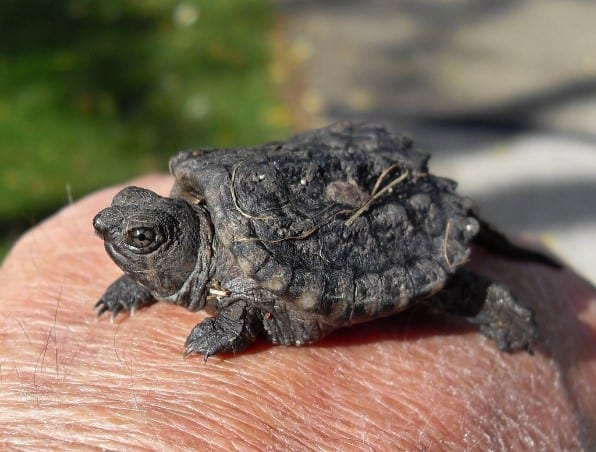
Epitome Source
The Alligator snapping turtle is the simply one of its kind to share a genetic background with Carbonemys cofrinii, the extinct prehistoric alligator snapping turtle species ancestor.
Because of its immensely stiff jawbones and the jumbo size, an adult alligator snapping turtle can reach, it is fully capable of literally burdensome other turtle species.
With their singled-out, primitive-looking advent, accentuated by a spiky beat, alligator snapping turtles are commonly referred to as dinosaur-like or the dinosaur of the turtle world.
The alligator snapping turtle can attain an average length of 1.1 – 2.v ft. An developed alligator snapping turtle usually weighs about 45 – 175 Ib.
Male person alligator snapping turtles are typically larger than females, which is a miracle explained by the species' sexual dimorphism. Apart from the size, the position of the cloaca in male vs. female alligator snappers besides varies.
It is cheers to the rugged carapace or the spiky upper shell how alligator snappers cover-up brilliantly in the wild. Alligator snapping turtles have large heads, oversized claws, unique, extremely powerful, hooked beak-like jaws, and quite crude skin. All of these physical characteristics make it easy to set autonomously an alligator snapping turtle from whatever other turtles known to inhabit freshwaters.
Types
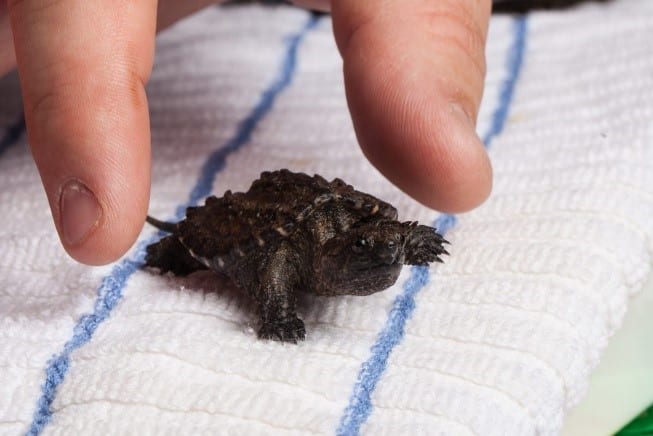
Image Source
The alligator snapping turtle belongs to the genusMacrochelys. Recently, this very genus was divided into 3 separate species categories, namely Macrochelys temminckii, and further K. Apalachicola, and Grand. Suwannensis . The latter two types of alligator snapping turtles are named later on the Apalachicola and the Suwannee Rivers where they happen to live.
Alligator snapping turtles' close cousins are the common snapping turtles. Withal, common snapping turtles belong to a dissimilar genus, the genusChelydra.
Habitat & Lifespan
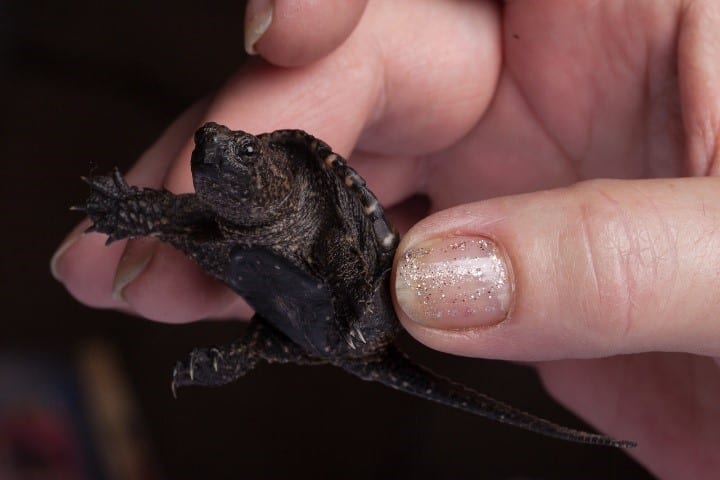
Image Source
Native to the Due north American continent, the natural habitat of alligator snapping turtles includes both wetland swamps and freshwater sources.
Access to freshwater is crucial for an alligator snapping turtle's habitat, equally they usually alive in deep water, such as these of large lakes, canals, rivers, and swamps.
Hatchlings are bred well-nigh smaller streams, also every bit well-nigh-surface water.
Alligator snapping turtles savor spending nigh of their time underwater. Yet, during the convenance female alligator snappers usually venture on land.
The lifespan of Alligator snapping turtles can be anywhere betwixt 10 – xl+ years, even though there accept been recorded examples of alligator snappers living as long as 70 years.
Housing/Caging
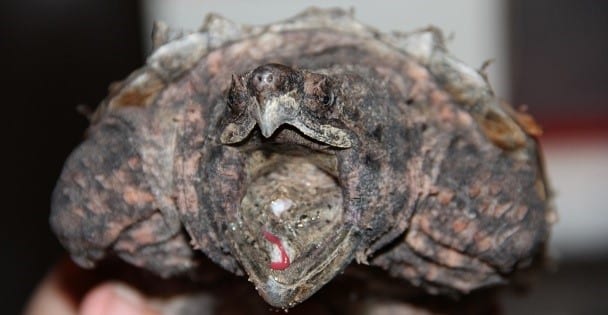
Image Source
- Small alligator snappers (less than one foot in length) can exist stored in a breeder tank/aquarium, however, this must be used only and strictly every bit a temporary solution. The expected growth rate of an alligator snapper is near 1 – 2 inches per year, and so an appropriately-sized habitat must be established accordingly.
- Alligator snapping turtles can be stored in livestock water troughs made of plastic or galvanized steel, and also known as stock tanks.
- In the example of housing alligator snappers in steel tanks, the tanks must exist lined with a suitable pond liner. A pond liner is crucial to help to forestall unwanted metals from leaching into the water, potentially posing dangerous health risks for the snappers. Plastic tanks do not crave lining, though.
- Readily-available stock tanks that come with plugs and drains for the purpose of ensuring proper, easy draining with a safety hose tin can exist an fantabulous option, although keepers can too embrace a DIY attitude on equipping stock tanks with the needed drainage devices. Mind that screens and stands are ordinarily custom-made by alligator snappers' owners.
- The minimum size capacity for a stock tank suitable to house an alligator snapper is 700 – 800 galloon (which is to typically occupy 16+ sq. ft. of space).
Size and Depth
- An adult alligator snapper will require a minimum of the 700-gallon capacity tank.
- The minimum depth of an appropriately-sized tank should be equally deep as the length of the turtle's crush, with the water level for an developed alligator snapper beingness semi-shallow at its all-time.
- The tank should be deep plenty as to allow the alligator snapping turtle to swim freely, yet simultaneously, it should be shallow enough to allow the turtle to sticks its neck upward, so that it can breathe, taking a fresh gulp of air whenever needed.
Substrate
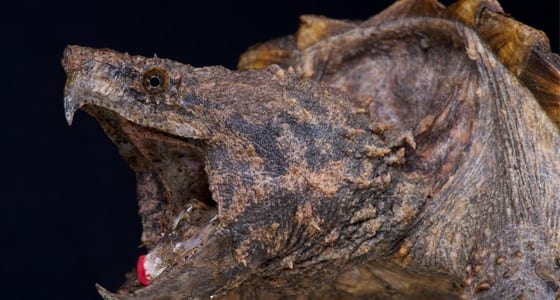
Image Source
- Provided a keeper is to store a juvenile alligator snapper in a tank, it is best not to use whatsoever substrate at all. Doing so helps to continue the water as make clean as possible hands, preventing algae and bacteria from developing and posing health risks for the reptile's well-existence.
- Even though juvenile alligator snappers can be stored in a tank without substrate, hiding places are essential. A place to hide will help the alligator snapper to feel much more comfortable.
- In social club to create hiding places your alligator snapper will enjoy, keepers tin make apply of plants and/or driftwood. Whether plants/driftwood are to exist existent or artificial is a matter of personal option, equally both options can piece of work fine for the purpose of satisfying the reptile's basic instinct.
- It is a skillful idea for an alligator snapper'southward tank to be lined with rocks. Information technology is important for keepers to choose rocks that are large enough Not to exist accidentally swallowed past the reptile.
- Alligator snapping turtles have a natural want to burrow, every bit this is how they typically wait for food. With this in mind, keepers must be especially careful with rocks and avoid opting for oddly shaped/sized rocks that could potentially trap the turtle beneath while it is trying to burrow itself.
- A smart fashion to avoid any accidents when using rocks every bit substrate is to opt for aquarium sealant or nontoxic epoxy to secure the selected rocks in place.
- Do NOT utilise precipitous rocks as they can scrape the alligator snapper's beat, leading to infections in return.
- Alligator snappers are most entirely aquatic. Even though they just bask every now and and so, providing admission to fresh air is crucial. A suitable basking/fresh air-breathing/resting area should exist shallow.
- Similarly to rocks, logs can besides provide a adept place for alligator snapping turtles to either hide beneath or climb out of the water whenever needed.
- Planting native vegetation and placing appropriate logs from the middle depths of the snappers' enclosure to the shallow h2o zones is yet some other brilliant way to provide the reptiles with places to hibernate.
- Information technology is quite possible that an alligator snapper volition eat some of the live plants in its enclosure. All the same, adding live plants is definitely worth the endeavor, as apart from providing hiding places and shade, plants too help the sediment related to slow-moving h2o to fall out.
- If the caregiver plans to go on an alligator snapper in a pond, the edge can be easily naturalized by using marginal plants, such equally rushes and cattails.
- Some other brilliant way to add together hiding places is to opt for driftwood and/or leaf litter, both of which further aid to acidify the water, and in return, to prevent algae growth.
- It is totally fine (and in fact, inevitable) for the leaf litter to sink to the bottom of the alligator snapper'southward enclosure. However, it is highly unlikely for the leaf litter to be stirred up by the reptile.
- Since the basic substrate for alligator snapping turtles is water, keeping oxygen levels high through proper air circulation is a MUST. In the wild, alligator snappers inhabit well-aerated tributaries, so promoting fresh air circulation is crucial, particularly for man-made ponds.
- For the purpose of promoting air circulation, fountains, external filters, air stones, and/or waterfalls can exist of not bad assistance.
- One of the biggest avails to providing a well-oxygenated enclosure for a captive alligator snapper is that this type of enclosure will naturally procedure most of the reptile's waste product, helping keepers by minimizing decomposable material and the associated cleaning services.
Temperature & Lighting
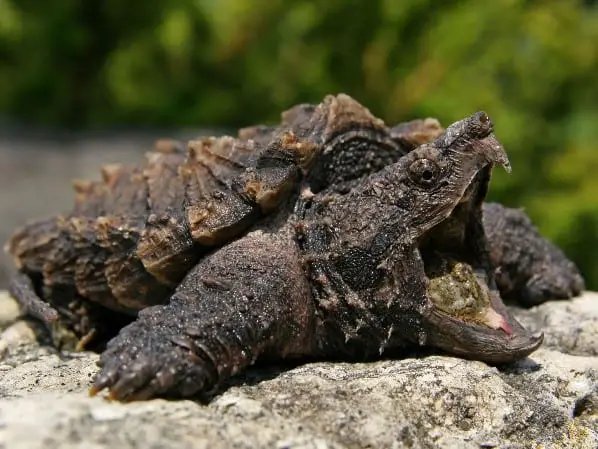
Paradigm Source
- In the wild, alligator snapping turtles can be found submerged at water temperatures varying from 70 to 74 °F.
- In captivity, the air temperatures must non fall beneath 65 °F equally in such cases, domesticated alligator snappers have been reported to refuse to eat.
- In club to preclude hibernation, which typically occurs during the showtime few years of an alligator snapping turtle's life, it is highly recommendable to keep the temperature at a abiding, year-round charge per unit of 82 °F.
- If y'all are to keep an alligator snapper outdoors, the sun volition provide all the natural heat needed for the reptile to successfully synthesize vitamin D3, without whatsoever further lighting supplementation. Vitamin D3 is especially of import for alligator snapping turtles' wellness, as it helps for the reptile's body to absorb calcium in lodge to build strong basic and shell.
- If yous are to proceed a juvenile alligator snapper in an indoor aquarium/tank, additional lighting is needed. UVB light volition aid caregivers keep an alligator snapper salubrious since it is the UVB wavelength of sunlight to assistance turtles synthesize Vitamin D3 successfully.
- It is a must to make sure that heating cables are enclosed in a plastic piping in order to keep the alligator snapper safe at all times.
- Enclose heating cables in a plastic pipe to keep your turtle safe.
Diet
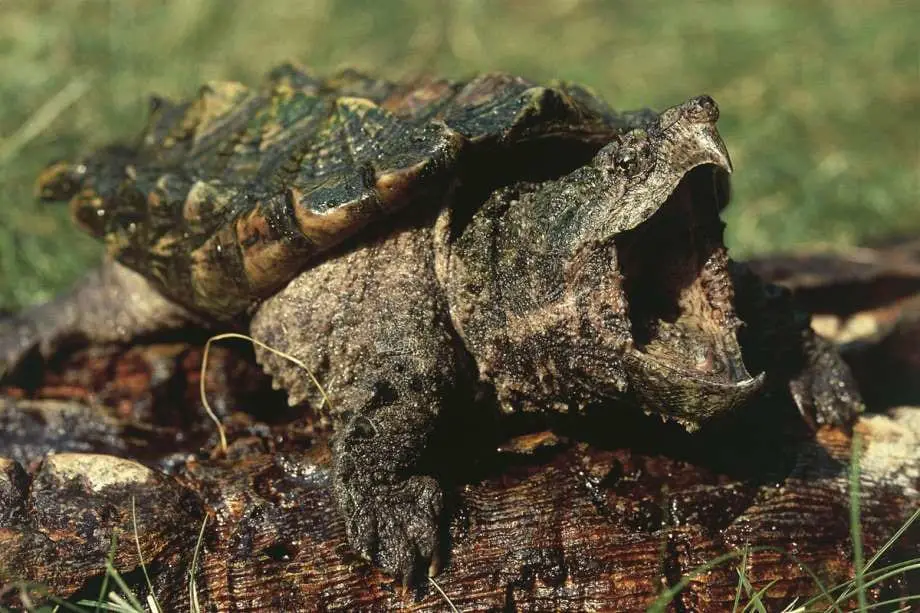
Prototype Source
Alligator snapping turtles are omnivorous animals, pregnant that they will gladly eat both plants and meat. Notwithstanding, alligator snappers tend to adopt consuming fish and invertebrates more ofttimes than they would prefer to eat plants.
Alligator snappers are known to exist opportunistic feeders, equally they rely on both dead organisms, besides as on living foods, depending on which they can scavenge.
Generally speaking, alligator snapping turtles are to eat (almost) annihilation.
Eating Habits
In general, alligator snapping turtles eat all-year-round, with the exception of refusing to eat because of high temperatures. In the wild, alligator snappers prefer to search for food in the winter season, rather than in the acme of the summer flavor.
Alligator snappers typically prefer to catch their prey, which is the case with fish. Some of the fish alligator snapping turtles love to feast on include mollusks, fish carcasses, carrion, amphibians, and crustaceans.
Part of the eating habits of alligator snappers is to prey on worms, crayfish, snakes, h2o birds, and even on other turtles. Eating aquatic plants is another part of the alligator snapper's feeding routine.
Fifty-fifty though only on certain occasions, snappers may casualty on nutrias, muskrats, aquatic rodents, and mammals of small to medium sizes, such every bit opossums and squirrels.
Usually, alligator snappers feed at night. Still, if hungry, they would gladly feed at any fourth dimension of the day or night.
In lodge to strike their prey, alligator snappers apply their tongue for the purpose of luring their victims closer. The alligator snapping turtle's tongue is wriggled in order to mimic worm-similar movements. It is through these worm-like movements how snappers attract fish and sure types of invertebrates.
Young alligator snappers are nearly commonly to use their tongues to take hold of various modest fish, such as minnows. However, for adults, active foraging is needed to satisfy their hunger.
Sleeping Habits
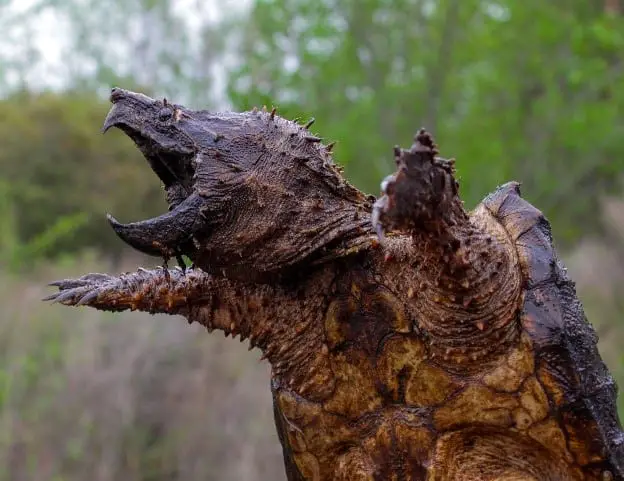
Image Source
Alligator snapping turtles are primarily active at dark. Existence nocturnal creatures, they hunt when the temperature conditions are on the cooler side.
Throughout the day, alligator snappers are to lie quietly at the bottom of the water, with their jaws kept open, waiting to catch their prey.
H2o
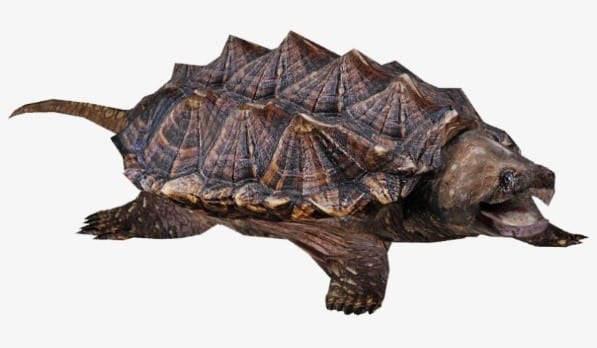
Prototype Source
In their natural habitat, alligator snapping turtles tin can be virtually commonly found in large rivers, as information technology is in large rivers where water is always moving, being cleaned and replenished past Mother Nature.
When it comes to the home environment, it is the keeper's task to maintain the water fresh and make clean at all times.
Every bit a rule of thumb, caregivers should be majorly concerned with maintaining the proper oxygen and nutrients levels in the alligator snapper'south water. When oxygen/ nutrients levels are out of the norm, this can cause algae to grow, posing health risks to the reptile's well-existence.
In social club to go on an alligator snapper's enclosure water clean in the instance of taking care of the reptile in a tank/aquarium, it is best to change the water frequently.
For keepers who are to accept care of an alligator snapper in an outdoor human being-fabricated swimming, using the proper equipment to sustain oxygen levels within the required rates is needed.
Water should be changed every i to four weeks. The frequency of irresolute h2o depends on the size of the tank, also equally the filters' capacity and overall functioning.
Using a uncomplicated h2o kit is an excellent way to mensurate nutrient levels in an alligator snapper'south water.
Development and Reproduction
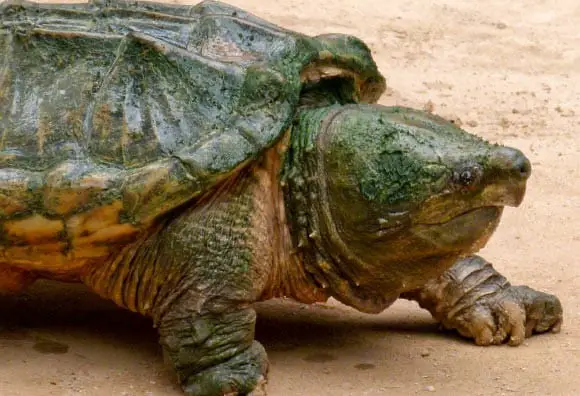
Epitome Source
- In the wild, the mating season for alligator snapping turtles slightly varies. For instance, in Florida, the mating flavour begins in early leap, while in Mississippi Valley information technology begins in late spring.
- Alligator snapping turtles are polygynandrous, pregnant that both females and males alike are to mate with more than one partner.
- Mating takes place one time a year, as it is seasoned for alligator snappers. Snappers reach sexual maturity when they are between 11 and xiii years erstwhile.
- During the breeding season, alligator snappers are known to get quite territorial. Once males are to find a potential female to mate with, they will mount the female's back a sing of demonstrating their mating blessing.
- Then they are to grasp the vanquish of the female person alligator snapper with their crooked, sharp anxiety for the purpose of inducing insemination.
- After fertilization, the female alligator snapper is to lay eggs in a nest. The nest is basically a hole which is dug in the sand approximately fifty meters abroad from a water source.
- The size of an alligator snapper'southward clutch depends on various factors. A single clutch tin contain annihilation from viii to 52 eggs. Incubation typically lasts for 100 – 140 days.
- Hatchlings are usually born at some point in the fall, and they are fully contained. It is the hatchling'due south independence at birth that is the principal reason for turning them into easy prey in the wild.
- It is the incubation temperature to determine the sexual orientation of newborn alligator snappers. Females are generally born at temperature of around 29 – 30 degree Celsius, while males are born at slightly lower temperatures, ranging from 25 – 27 degree Celsius.
- A newborn alligator snapping turtle'south appearance is quite like to that of adults, except for the size.
- Baby alligator snapper turtles casualty on guppies, crayfish, tadpoles, snails, as well every bit various small-scale invertebrates in the water.
How to Breed
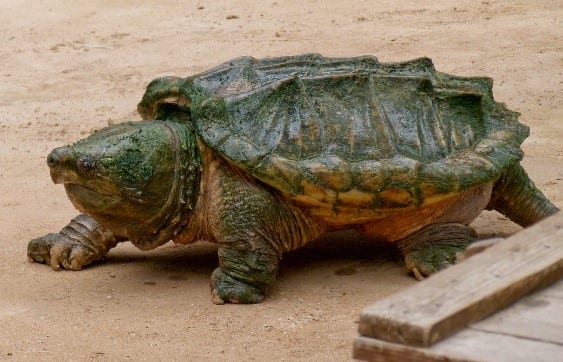
Epitome Source
- If a keeper is to breed alligator snappers, a good for you male and a healthy female person snapper must be brought together.
- Alligator snappers achieve sexual maturity between 11 – sixteen years of age.
- It is the changing season to stimulate adult snappers to mate, and considering of this, convenance is best to take place outdoors.
- The male and female alligator snapper should be kept together for a couple of months, as to provide them ample mating opportunity.
- In captivity, alligator snappers typically mate betwixt February–October. They produce a clutch of 10 – 50 eggs within an average of 2 months afterward mating.
- For convenance captive alligator snappers indoors, the eggs must be incubated by the keeper by placing them over well-moistened (but non soaking wet) vermiculite, and maintain a temperature of betwixt 77 – 86 degree Fahrenheit. The vermiculite should exist sprayed periodically as non to dry out and kept constantly moist until the eggs hatch.
- Breeders can determine the sex of alligator snappers' offspring by incubating the eggs at different temperatures accordingly.
- Breeders tin can tell whether the eggs are fertile provided a clear subgerminal infinite (resembling a chalky white spot) is to appear on the eggshells.
Handling
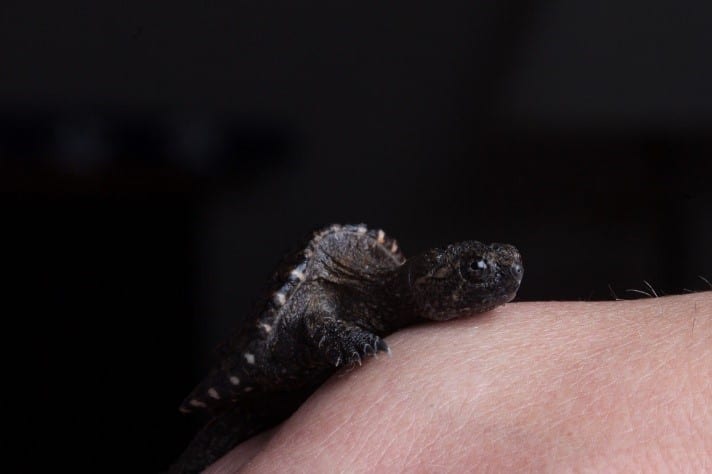
Epitome Source
- Equally a rule of thumb, retrieve that alligator snapping turtles must never be picked by the tail. Picking an alligator snapper by the tail can cause massive, serious, ofttimes irreversible damage to the spinal cord.
- Go along in mind that mature alligator snappers are equipped with claws that attain the length of a human's finger. They too possess a powerful beak, and they volition not be afraid to put it to use on the keeper's toes, fingers, or any other body parts.
- Treatment an alligator snapping turtle must only be approached by owners who have sufficient experience with turtles in general and/or take been properly trained how to exercise and so.
- Due to the massive size of mature alligator snappers, handling tin can be especially challenging, since an developed snapper can counterbalance just as much every bit an adult person. The goal is to grasp the turtle just behind its head, every bit well every bit in front of the tail every bit to limit its ability to bite accidentally. Snappers can bite even through broom handles, then make sure to be extremely careful about their oral fissure' placement when treatment.
- Small alligator snapping turtles can exist held but like whatsoever other turtle. The keeper simply needs to grasp the sides of the turtle's shell.
How to Treat and Prevent Possible Wellness Issues
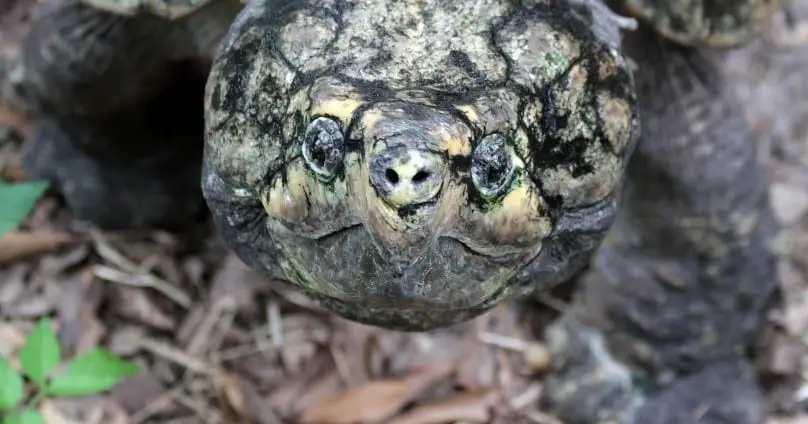
Image Source
Algae
Algae buildup tin lead to infections or injuries on your alligator snapping turtle's beat. Such problems may require to exist addressed every bit quickly as possible by a qualified veterinary, even though keepers can manually remove some of the algae past scrubbing the turtle'southward shell periodically using room-temperature, make clean water and a soft castor.
Shell Rot
Fungal, as well every bit bacterial organisms, can cause the alligator snapper'due south beat out to be infected.
Shell infections can result because of scratched on the crush'southward surface, such as, for instance, from a precipitous stone. Improper husbandry weather condition tin can also lead to infections that are capable of weakening the reptile's immune system.
Nonetheless, the lack of an appropriate heat source and/or fresh, clean h2o tin besides pose risk for shell infection-related disease.
As crush infection may easily spread throughout an alligator snapper's body, it is crucial for owners to address such issues immediately.
Usually, owners tin can spot crush rot if a light spot is to appear on the alligator snapper'due south shell.
If your alligator snapping turtle's shell becomes infected, it is best to pay your vet a visit immediately. Daily treatment with a broad-spectrum topical antiseptic may be recommended and/or lightly scrubbing routines of the infected areas.
In severe cases, however, the beat may break off in pieces, and foul smell is often to occur as a event.
Swollen Eyes
If you observe that your alligator snapper'due south eyes announced swollen, this may be an indicator of respiratory infection. Such blazon of infection is typically treated with antibiotics.
Although rarely, swollen optics may upshot because of lack of Vitamin A in the reptile'due south diet, a condition known as hypovitaminosis A. However, with a proper, varied diet, hypovitaminosis A should not be an issue.
Shell Injuries
In the case your alligator snapping turtle's vanquish is cracked, keepers can rinse the beat using saline, and proceed past applying povidone-iodine temporarily. Subsequently, the treated surface area must exist covered with sterile gauze, and owners should contact a veterinarian.
Abscesses
If injuries are to get untreated, this tin lead to abscesses, filled with caseous, which is a particular semisolid discharged past the reptile. Such type of injuries can occur literally anywhere on your alligator snapper's torso.
In the example such an injury does not go abroad on its ain within a couple of days, information technology is best to come across a veterinarian for further consultation.
Possible Dangers to Humans
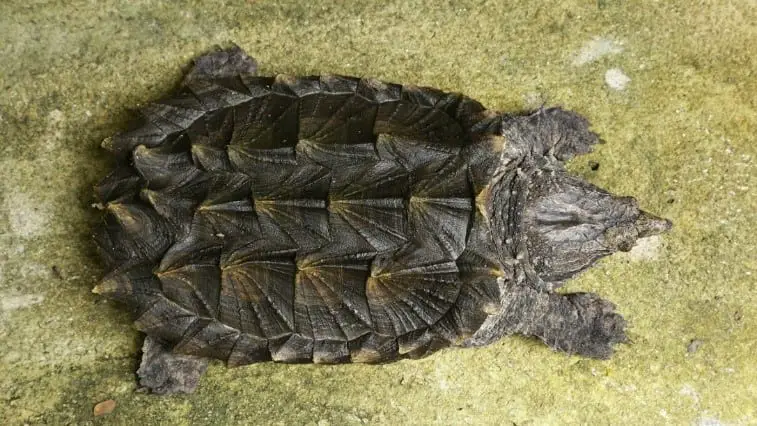
Prototype Source
Apart from their notoriously mighty, powerful bite, that can lead to harsh consequences, alligator snappers, similar to other reptiles, tin be carriers of Salmonella bacteria.
Salmonella bacteria carried from reptiles tin can crusade salmonellosis in humans. Salmonellosis is a gastrointestinal disorder, ofttimes leading to fever, abdominal cramps, diarrhea, intestinal cramps, and/or airsickness.
Although simply in rare cases, Salmonella can spread to the human'due south blood, brain, and bones.
It is incommunicable to tell whether your alligator snapping turtle has salmonella bacteria on its torso or not just past looking at information technology. However, owners can protect themselves, equally well as their families, by washing their hands thoroughly every time after handling the reptile pet. Too, keepers must avoid touching their mouths prior to washing their hands with clean water afterward handling the turtle.
As young children's systems are not fully mature, they are at college risk of developing Salmonella infections-related complications.If children under v are living in the home, the Center for Affliction Control and Prevention strictly recommends not to own a reptile and/or amphibian.
Beliefs
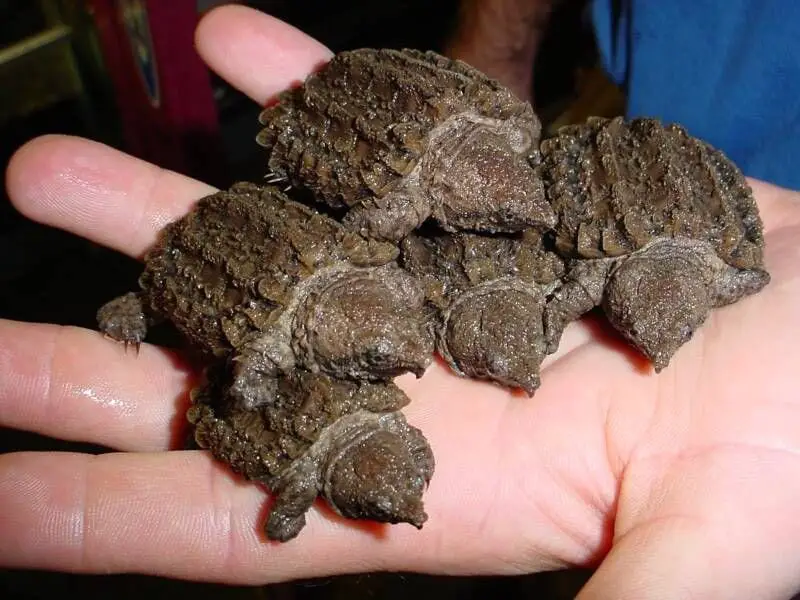
Image Source
Despite its ferocious name, the alligator snapping turtle is not really very aggressive.
In their natural habitat, alligator snappers are to chase by lying motionless, standing still in the water and only displaying their pink-colored tongue, resembling a burrowing worm, in order to lure their prey.
Sometimes, alligator snappers tin can wait patiently for up to a full hour before afish is to swim into their open mouths.
Sometimes, alligator snappers besides like to bury themselves in the mud, and so that but their nostrils and eyes are left exposed, demonstrating notwithstanding another astounding, non-ambitious accommodation to catch prey.
In full general, alligator snappers are lonely creatures. In the wild, the alligator snapping turtle's radiating yellow patterns located around the eyes, coupled with algal growth roofing the carapace, allow for this mesmerizing creature to become easily and naturally camouflaged.
Even though alligator snappers are not aggressive by nature, they exercise get quite aggressive if they are to defend themselves. They also tend to dislike social interaction.
In cases when the alligator snapper is forced to leave its comfy resting spot, it typically chop-chop becomes agitated, and in return, very aggressive.
If picked up and/or attacked, an alligator snapping turtle is to rapidly shoot its head forward incredibly fast, then use its enormous, strong jaws to bite, delivering a painful wound.
Availability: How to Go an Alligator Snapping Turtle
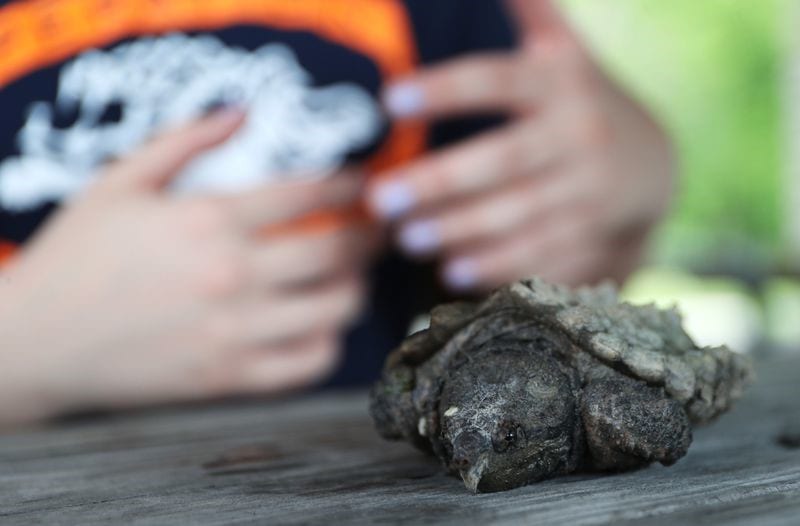
Image Source
Keeping in mind the legal protections against the commercial sale and/or harvest of alligator snapping turtles in many countries and states, it might be the example that ane of the only ways to go one would be to buy it online.
As a rule of thumb, if an alligator snapper has not been cared for properly, it may fail to survive, regardless of whether or non the side by side keeper is to accept the best care of information technology.
Always acquire an alligator snapper only through a legitimate dealer, rescue, and/or breeder. Doing then volition not just permit you to lay hands on good for you, properly treat alligator snapping turtles, but will as well grant you lot proof of buy that can be needed if the local wildlife authorities are to crave it from you.
Alligator snapping turtles sold past street vendors are best to be avoided.
Mind that young hatchling, no matter how cute, tend to be less hardy than the alligator snappers provided with more than time to mature before being purchased and taken domicile.
Fun Facts
- In the wild, the alligator snapping turtle is one of the heaviest turtles on the planet. However, it was at the Tennessee Aquarium where one of the largest alligator snapper specimen, weighing 249 Ib., was recorded back in 1999 at the historic period of 16 years. The maximum carapace length of 2.eight feet was recorded at the Brookfield Zoo when another massive specimen was measured to weigh 236 Ib!
- The bite force of an alligator snapping turtle is actually less than that of other turtles. Even though alligator snappers can seize with teeth through the handle of a broom without whatever difficulty, there have been only very rare cases of human fingers bitten off by this legendary turtle species.
- It is cheers to the algae that ofttimes tends to abound on the alligator snapper's beat how this unique reptile manages to camouflage masterfully in the wild.
- Information technology is cheers to an adaptation known as Peckhamian mimicry how alligator snapping turtles lure fish, using their inconspicuous mouths and the worm-shaped appendage at the very tip of their tongues.
- Prior to emerging for air, alligator snappers can stay submerged for between xl – 50 minutes.
- Unlike most other snapping turtles, alligator snappers accept eyes located on the very sides of the caput.
- The prehistoric look of an alligator snapper has much to do with the reptile's distinct features, such as rocky built ridges, a triangular head, and nonetheless, the little eyelashes-like bumps.
- Without any doubt, the alligator snapping turtle is the closest animate being to a pet dinosaur that a person can possibly own nowadays.
- The specific epithet temminckii establish in the scientific name of the alligator snapping turtle honors Coenraad Jacob Temminck, a Dutch zoologist.
How to Take Care of an Alligator Snapping Turtle
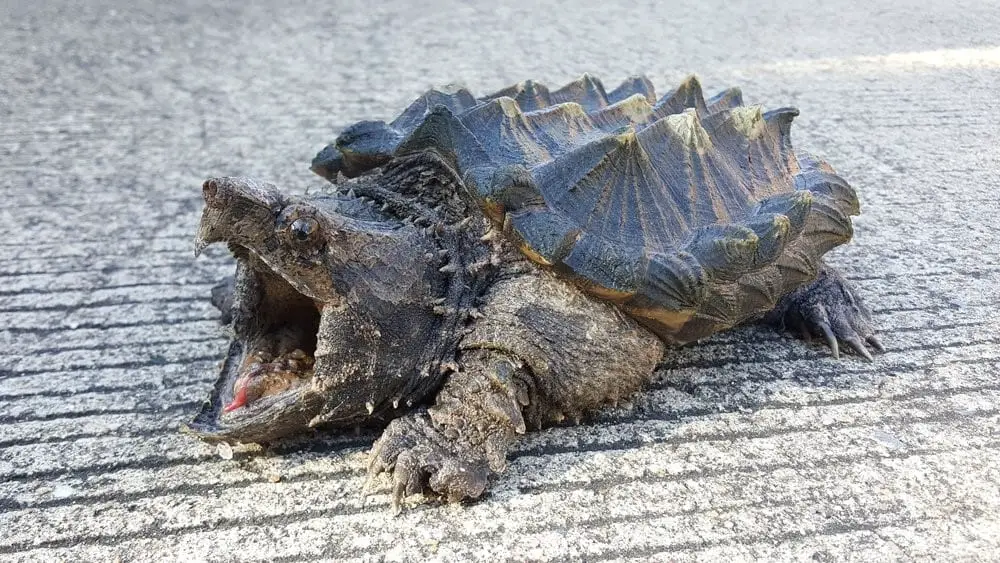
Image Source
- If you plan to continue an alligator snapping turtle as a pet, the first and foremost affair to proceed in mind is an incredible size that this reptile can accomplish.
- A juvenile alligator snapping turtle tin can be stored in aquariums with low sides, similar breeder's tanks. However, information technology volition eventually outgrow this type of enclosure.
- 150+ pound alligator snapping turtles demand to be taken intendance of outdoors, such every bit, for case, in a greenhouse, so that adequate temperatures tin be sustained past the keepers.
- Juvenile alligator snappers are to grow at a rate of 1 – 2 inches per twelvemonth on an average.
- As soon every bit an alligator snapper is to attain ane foot in length, owners need to movement their pet into a livestock h2o/ swimming.
- Think that it is all upwards to the alligator snapping turtle's keepers to maintain the freshness and cleanliness of the water, also as to control and maintain the oxygen/ nutrient levels appropriately.
- Information technology is good to go on in mind that alligator snappers produce a lot of waste matter. Also, they are known to make quite a mess of their food. Because of this, owners should be aware that water in the tank/pond should be filtered and circulated on a regular basis.
- For alligator snapping turtles owners who live in a libation climate, adjusting and maintaining the water temperature within the desired rates is a must.
- Every bit long as caregivers are to provide their alligator snapper pet with clean, well-aerated h2o, a identify to swim, as well equally a place to hide, suitable heat source, and a proper diet, owning this unique reptile is bound to be a beautiful journeying.
- Hatchlings should be fed every day, while adult alligator snappers should exist fed every other day.
- A diverse, well-balanced nutrition is primal.
- Only feed alligator snappers as much every bit they will swallow, since whatever uneaten repast is to make their h2o dirty.
- Offer your alligator snapping turtle the corporeality of nutrient that equals the size of its head. Although merely a loose suggestion, doing so can greatly help owners to institute a solid understanding of the reptile's eating habits, and to avoid getting the water dirty, as this tin can cause more than damage than whatsoever adept to the pet.
- It is based on the turtle'southward feeding response how owners can know whether they need to decrease or increase serving size.
- Mind that for convict alligator snapping turtles, letting them hibernate may be a risky move unless y'all are to provide the same conditions as in the wild. Information technology is easy to prevent an alligator snapper from entering hibernation by simply keeping the h2o temperature on the high sides of the recommended norm, instead of on the depression sides.
- In the wild, alligator snappers are known to be nocturnal feeders. When kept in captivity, though, they often tend to exist active both during the solar day, likewise as during the dark, and so owners tin can experience gratis to establish a feeding routine accordingly.
FAQs
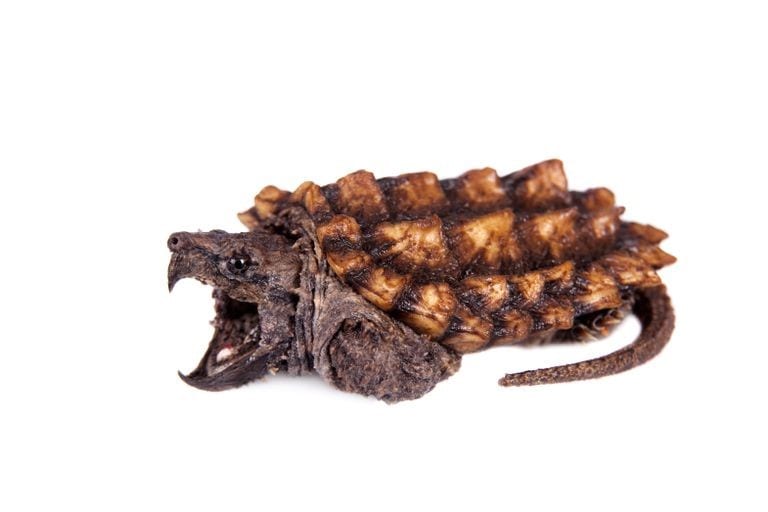
Image Source
How Potent is the Seize with teeth of an Alligator Snapping Turtle?
Even though common claims associate the power of an alligator snapping turtle'due south bite as one of the Chelydra bite forces in the wild, this is pretty much a myth. Several other species of turtles possess stronger bite force than that of alligator snapping turtles. The bite force of an alligator snapper is about the same every bit that of humans and is unremarkably relative to the size of the turtle's trunk.
Are Alligator Snapping Turtles Aggressive?
No, alligator snapping turtles are non ambitious by nature, and they are not known to assail unless grabbed by the shell and/or attacked past a predator. In fact, alligator snapping turtles are known to be less ambitious than mutual snapping turtles. Since scientists know also little about alligator snappers, though, it is all-time to avoid getting this reptile aroused and/or teasing it, as the seize with teeth can be painful and damaging to human being beings and animals alike.
Can You Release a Pet Alligator Snapping Turtle in the Wild?
In the wild, alligator snapping turtles inhabit freshwater sources. However, since not all local freshwater locations may exist suitable because of various reasons, such as possible contaminants, amongst many others, it is best not to release your pet alligator snapping turtle in the wild before consulting with a qualified veterinarian.
How Often Do Alligator Snapping Turtles Need to be Fed?
Hatchling and juveniles alligator snappers should be fed daily. Adult alligator snapping turtles should be fed but every other day. Giving too much food tin issue in making the alligator snapping turtles' water dirty, so merely feeding as much as they actually need is crucial in order to sustain their health and well-beingness.
Tin You lot Keep an Alligator Snapping Turtle as a Pet?
Yeah, yous can go on an alligator snapping turtle as a pet only yous exercise e'er demand to get well-acquainted with the local laws and regulations in your surface area of residence prior to purchasing an alligator snapper pet. Because of their sharp claws, potent jaws, and massive size in mature historic period, alligator snappers are not recommended as pets for small-scale children anile beneath half dozen years. Potential alligator snapping turtle pet owners must be well-trained on how to approach, handle, and treat the reptile as to stay away from any possible trouble.
Why Are Alligator Snapping Turtles Of import to Humans?
Currently, due to habitat degradation, as well as due to overharvesting for their meat, alligator snapping turtles populations in the wild take been apace on the decline. Sadly, information technology is humans who are the only natural predator for alligator snapping turtles, and the major driving strength for alligator snappers' declining. Alligator snapping turtles are of import to humans as they are a unique part of the ecosystems on the planet, making upwardly for the natural, vital balance on Globe.
Tin an Alligator Snapping Turtle Recognize its Owner?
Yes, it is possible for an alligator snapping turtle to recognize its owner/caregiver, especially after spending several years kept and fed past a item person. Experts believe that is non only the sounds of their owners that alligator snappers, and other turtles akin, can recognize, but it may be also the sight of them, likewise. Some alligator snapping turtles owners report for their reptile pets to even come to them when chosen past name or through a certain sound, after proper, continuous training, even though some experts reject to believe that turtles can recognize other than mating sounds.
Tin can you Tell How Quondam an Alligator Snapping Turtle Is by Looking at information technology?
It tin be very hard to tell the exact age of an alligator snapping turtle only by looking at information technology. Yet, one can mensurate the alligator snapper'southward carapace, and so count the almanac rings in guild to get a good thought of the reptile's age. The most accurate way to tell the age of an alligator snapping turtle is to bank check its hatch date and/or to visit a qualified veterinarian.
Do Alligator Snapping Turtles Go Lone?
Alligator snapping turtles, similarly to other turtles, are not social creatures. Owners tin can put more than one alligator snapping turtle in a pond/ tank, however, this may often bespeak more impairment than any skillful, since alligator snappers do not really need another reptile friend. Alligator snapping turtles do not get lone, and are rather solitary animals ane can leave unattended for days, if not weeks, provided their water and nutrient demands are met accordingly.
Can you Pet an Alligator Snapping Turtle?
Alligator snapping turtles, like all turtles in general, do non similar being petted. That doesn't hateful alligator snapping turtles cannot make keen pets but it just ways that owners must acknowledge and respect the reptile'due south needs and demands, one of which is non to be handled and petted frequently and/or in the same manner as a person is to pet a dog, for example.
Source: https://reptilescove.com/care/turtles/alligator-snapping
0 Response to "Are Newborn Baby Alligator Snapping Turtles Born With Their Eyes Shut"
Post a Comment